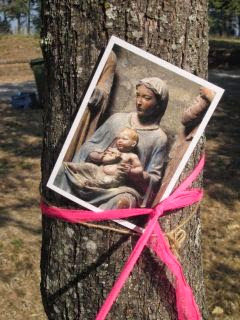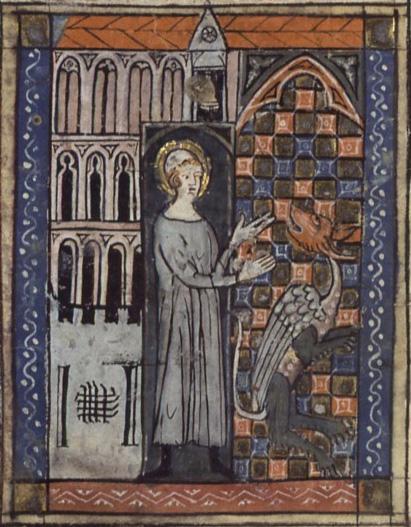Angels
Generally speaking, almost every religion recognizes Angels.
Sometimes they have wings and sometimes not.
Sometimes they have bodies and sometimes not.
In Christian iconography they are always beautiful, ageless and androgynous beings in gowns *,
apart from putti, those plump and rosy toddlers,
who apparently are quite acceptable as naked little boys.
The word Angel is often translated to mean "messenger of God",
and sometimes it is defined as someone who has transcended
above the mean pettiness of being human.
Allegedly, more people than not believe in Angels,**
especially Guardian Angels, who have helped
them in times of need.
Workmen Angels
An exhibition of larger than life-size photographs
mounted on the outside walls of the market
as part of the VI Bienale Internationale d' Arte Contemporaine de Melle.
Then the unthinkable happened.
Of course there are many unthinkable things.
And I hasten to add that I am still grateful that this particular unthinkable
thing wasn't that Louise and I had crashed and I was critically injured.
My unthinkable thing was that I lost the keys.
A small but paralysing thing to do.
On an unmarked road in the middle of nowhere
I discovered that I had lost all but one of Louise's keys.
I still had the ignition key, but without the immobiliser "key",
trying to start the engine would only activate an unstoppable and deafening siren.
I had taken this road only as a detour to find a quiet picnic spot,
which I had found, but I hadn't looked for any signs to say where I was
nor took particular notice of any houses I might have passed.
So I walked back the way I had come, anxious that
without the wheel lock key, my most precious friend and companion
was completely vulnerable to being wheeled away like the proverbial lamb to slaughter.
After a couple kilometers I flagged down the only passing car.
The driver listened with that familiar look of incomprehension to my story of woe
and delivered me to the door of the Mairie who could speak English.
The Mairie and his wife were on the balcony finishing their coffee and newspapers
and leapt to my assistance.
They drove me back to Louise and helped us freewheel down the remarkably
flat stretch of road to their house.
The Marie trotted alongside me, smiling encouragement and
pushing whenever we ground to a halt.
The Marie's wife offered to take me to where I had last used the keys and didn't balk as I grimaced
and said that it was over 35 kilometers away. After we re-enacted my movements and had searched the spot in vain, we visited the local mairie and the police.
Then we slowly returned to their house while we scanned the road,
and for a few seconds a shriveled black banana skin had raised our hopes.
The sun was setting and the Marie's wife announced,
"There is nothing else we can do now so you must stay the night",
and with that she showed me to my room,
pressed a fluffy toweling dressing gown into my arms and pushed me into the bathroom.
Despite the neighbour's concern that I might kill them in their beds,
I stayed a few days: resting in a real bed after weeks of camping, eating home-made cakes, practising my French and watching English videos to practise her English.
The Mairie de-mobilised the immobiliser with worryingly simple instructions over the telephone
and drove me many kilometers to purchase a new wheel lock.
Then it was time to go. I folded my freshly washed clothes, tucked the packed lunch which the Mairie's wife had made into my pannier and set off on the last leg of my journey.
French Angels
Brigitte, Jean and T2
Aquarius, the water bearer, the altruist and humanitarian.
A fountain in Parthenay
* Archangel Michael slaying the Devil
Having said that most Angels wear gowns, Michael is often depicted wearing clothes more suitable for the business of slaying devils. Of course, we must remember that symbols, such as armour, spears, evil-looking horned figures are metaphorical guides used to tell a story.
Now days, slaying devils is much more complicated and subtle.
We can, if we choose, rise above all the pettiness, greed, and short sightedness of our extremely slow to learn human nature and slay devils with wisdom and compassion.
I can't say that I have I seen any historical evidence which proves that nuclear weapons,
machine guns, sub-machine guns, grenades, bow and arrows, rifles, machetes, land mines,
canon balls, mortar launchers, drones etc etc etc *** have truly been successful
as we still have all the same old problems.
*** to see how impressively busy and inventive we have been
at not using our wisdom and compassion, visit
http://en.wikipedia.org/wiki/Lists_of_weapons
** who believes in Angels?
77% of Americans, Italians and Croatians
between 25-33% of Danes
36% of Britons
http://www.foxnews.com/opinion/2012/10/21/do-believe-in-angels.html
"You do not see angels so much as feel their presence," said Father
Lavatori, adding: "They are a bit like sunlight that refracts on you
through a crystal vase."
http://www.telegraph.co.uk/news/worldnews/europe/italy/10530177/Angels-exist-but-have-no-wings-says-Catholic-angelologist.html























